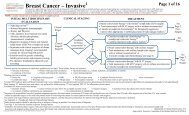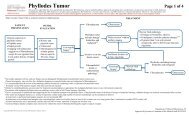MEDICINE
1YkigAQ
1YkigAQ
You also want an ePaper? Increase the reach of your titles
YUMPU automatically turns print PDFs into web optimized ePapers that Google loves.
Research<br />
Research Summaries<br />
36<br />
THE UNIVERSITY OF TEXAS MD ANDERSON CANCER CENTER<br />
Using observational data from the Center for International Blood and<br />
Marrow Transplant Research, Stefan Ciurea, MD, SCT/CT, compared<br />
survival outcomes between haploidentical donor transplant with<br />
post-transplant cyclophosphamide and HLA-matched unrelated donor<br />
transplantation in patients with AML [Blood 2015; 126(8): 1033-40]. Analysis<br />
revealed that three-year probabilities of OS were comparable following<br />
both of the two transplant modalities. However, acute and chronic<br />
GVHD occurred at a substantially lower frequency after haploidentical<br />
transplantation, possibly due to donor source or use of post-transplant<br />
cyclophosphamide. Limitations of this analysis warrant a trial randomizing<br />
hematologic patients to one transplant modality versus another.<br />
Musa Yilmaz, MD, Jorge Cortes, MD, and others in Leukemia evaluated<br />
the impact of chronic TKI use on kidney function in patients with chronicphase<br />
CML [Cancer 2015; 121(21): 3894-904]. The study followed 468 newly<br />
diagnosed chronic-phase CML patients being treated with TKIs and found<br />
that 4% developed acute kidney injury and 14% developed chronic kidney<br />
disease during this time, with a majority receiving imatinib. Both imatinib<br />
and dasatinib were associated with a decline in glomerular filtration rate in<br />
patients with normal kidney function at baseline; however, these changes<br />
did not impact response rates. This study revealed important data about<br />
the long-term effects of TKI therapy on renal function.<br />
Richard Champlin, MD, Elizabeth Shpall, MD, and others in SCT/CT<br />
evaluated the prognostic significance of European LeukemiaNet (ELN) risk<br />
classification and age in predicting allogeneic hematopoietic stem cell<br />
transplant outcome for AML patients in first complete remission [Biology<br />
of Blood and Marrow Transplantation 2015; 21(8): 1405-12]. In this study, ELN<br />
category was classified by FLT3-ITD mutation status, and patients were<br />
considered in two age groups, below 60 years and 60 years or older. This<br />
system was able to stratify both age cohorts into separate favorable and<br />
adverse transplant outcome groups, suggesting that it could also be used to<br />
classify patients in clinical trials for post-remission therapies.<br />
Supportive Care<br />
Kimberson Tanco, MD, (pictured)<br />
Eduardo Bruera, MD, Palliative,<br />
Rehabilitation & Integrative Medicine<br />
(PRIM), and an international team<br />
compared patients’ perception of<br />
physician compassion after watching<br />
video vignettes of two physicians<br />
conveying a more optimistic vs. a<br />
less optimistic message to determine<br />
physician preference and establish<br />
clinical predictors of compassion<br />
[JAMA Oncology 2015;1(2): 176-83]. Both<br />
physicians made the same number of<br />
empathetic statements and displayed<br />
identical posture. Patients reported significantly better compassion scores<br />
after watching the more optimistic video. Patients preferred physicians<br />
who provided a more optimistic message, indicating that more research is<br />
needed in structuring less optimistic message content to support health<br />
care professionals in delivering less optimistic news.<br />
patients at a general public hospital, distress intensity was twice that of<br />
patients at a comprehensive cancer center. More than 30% of patients<br />
rated financial distress to be more severe than physical, family, and<br />
emotional distress. The group advised that more research is needed to<br />
better characterize financial distress and to develop possible interventions.<br />
Bruera, David Hui, MD, (pictured) and<br />
colleagues in Korea evaluated and<br />
diagnosed 432 consecutive patients<br />
seen for chemical coping [The Oncologist<br />
2015;20(6): 692–7]. Chemical coping<br />
occurs when patients use opioids in a<br />
nonprescribed way, which can lead to<br />
misuse of and complications including<br />
neurotoxicities, respiratory depression,<br />
and death. Proper diagnosis and<br />
documentation is needed to avoid<br />
unnecessary harm. Approximately 18%<br />
of advanced cancer patients seen by a<br />
palliative care service were diagnosed<br />
with chemical coping, but only 4% were documented as such in the medical<br />
records. Researchers concluded that better and safer ways are needed for<br />
physicians to assess and report chemical coping.<br />
Hui, Bruera, and team members from Biostatistics surveyed oncology<br />
specialists and found that hematologic specialists were less likely than<br />
solid tumor specialists to report that they would refer symptomatic patients<br />
with newly diagnosed cancer to palliative care [The Oncologist 2015;20(11):<br />
1326–32]. However, both groups were significantly more willing to refer<br />
patients earlier in the disease trajectory if the service name “supportive<br />
care” was used instead of “palliative care.” These findings suggest that<br />
rebranding might improve patient access to palliative care services.<br />
Hui, Bruera, and colleagues from Biostatistics, Leukemia, and Thoracic/<br />
Head and Neck Medical Oncology surveyed hematologic and solid tumor<br />
oncology specialists to examine various aspects of end-of-life care [Annals<br />
of Oncology 2015;26(7): 1440–6]. They found significant differences in attitudes<br />
and beliefs toward end-of-life care between hematologic and solid tumor<br />
specialists, and identified opportunities to standardize end-of-life care.<br />
Compared with solid tumor specialists, hematologic specialists were more<br />
likely to favor prescribing systemic therapy with moderate toxicity and no<br />
survival benefit for patients. Hematologic specialists felt less comfortable<br />
discussing death and dying and hospice referrals, and were more likely to<br />
feel a sense of failure with disease progression.<br />
Hui, Bruera, and colleagues in Brazil studied variations in vital signs in the<br />
last days of life in 357 patients with advanced cancer [Journal of Pain and<br />
Symptom Management 2014;48(4): 510–7]. Although blood pressure and oxygen<br />
saturation decreased in the last days of life, they cautioned that clinicians<br />
and families cannot rely on vital sign changes alone to rule in or rule out<br />
impending death, as a large proportion of patients had normal vital signs<br />
in the last days of life. Their findings do not support routine vital signs<br />
monitoring of patients who are imminently dying.<br />
Bruera and team members from PRIM and General Oncology teamed with<br />
colleagues in France to study financial distress and its associations with<br />
physical and emotional symptoms and quality of life among advanced<br />
cancer patients [The Oncologist 2015;20(9): 1092-8]. From interviewing 149<br />
patients, they found that financial distress was very frequent, but among






